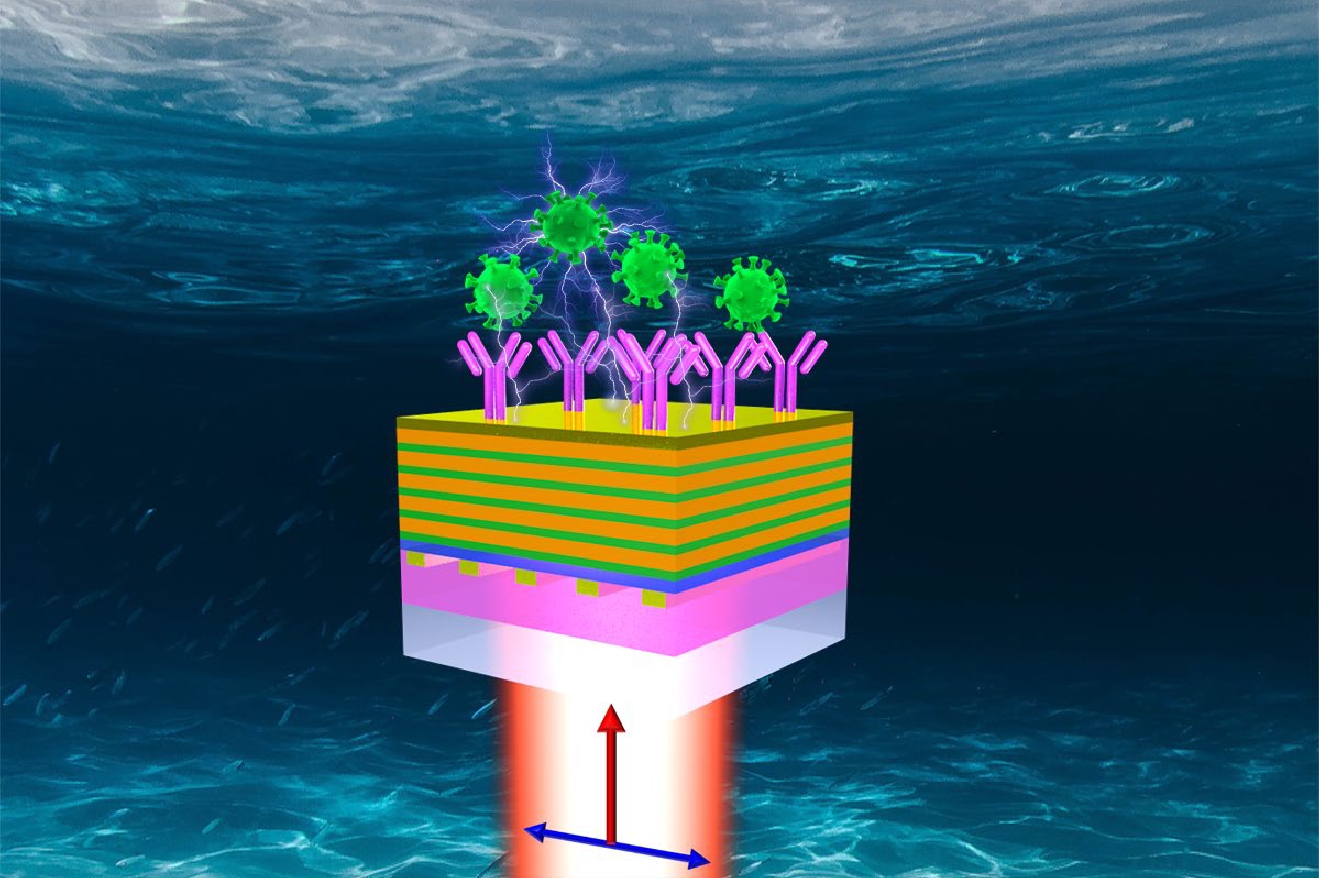-
摘要
基于棱镜耦合的金膜表面塔姆等离激元(Tamm plasmon polarition, TPP)与表面等离极化激元(surface plasmon polariton, SPP)的杂化耦合受到广泛的关注和研究,但这种传统的激发装置由于拥有体积庞大的棱镜等光学元件以及对入射光角度精准控制有严格要求,限制了其集成化发展和实际应用。为了简化TPP和SPP杂化耦合激发方式,本文提出了一种光栅耦合型多层堆叠结构设计。该结构主要包括三部分:顶部纳米厚度的金膜、中间一维布拉格光子晶体以及底部金纳米光栅。在该结构中利用底部纳米光栅的一级透射光同时实现了顶部金膜上下表面SPP和TPP共振激发。两种模式之间的耦合杂化作用极大地减少了模式的共振带宽,从而使TPP-SPP模式的传感品质因数得到了显著的提高。此外,通过改变纳米光栅的周期和组成一维布拉格光子晶体的介质层厚度,SPP和TPP可以在较宽光谱范围内实现耦合杂化。相比于传统棱镜式的TPP和SPP双模式耦合结构,设计的光栅耦合型的多层堆叠结构无需借助棱镜和对入射角精确调控,在正入射光照射下就可实现两种模式的共振耦合,这不仅易于结构的进一步集成和小型化,同时对拓宽表面等离激元传感器的实际应用具有重要的意义。
Abstract
The hybrid coupling of Tamm plasmon polariton (TPP) and surface plasmon polariton (SPP) on the surface of a gold film based on the prism coupling has attracted extensive attention and has been widely investigated. However, the traditional excitation configuration has bulky optical elements and requires accurate control of the angle of incident light, which limits its integration and practical application. In order to simplify the excitation condition of the TPP-SPP hybrid mode, a feasible grating-coupled multilayer stack structure is proposed in this paper. The structure mainly consists of three parts: a nanometric thin gold film on the top layer, a one-dimensional Bragg photonic crystal in the middle, and a gold nanograting on the bottom. In this structure, the SPR and TPP resonance excitations on the upper and lower surfaces of the top gold film are simultaneously achieved by utilizing the first-order transmitted light of the bottom nanograting. The hybrid coupling between the two modes greatly reduces the resonance bandwidth of the generated mode, thereby significantly improving the sensing figure of merit of the generated mode. Additionally, the hybrid coupling of both SPP and TPP modes can be realized in a wide spectral range by altering the period of the nanograting and the thickness of the one-dimensional Bragg photonic crystal. Compared with the traditional prism-coupled TPP and SPP dual-mode coupling structures, the designed grating-coupled multilayer nanostructure can realize the resonant coupling of the two modes at the normal incidence without prism and limitation of incident angle. This not only facilitates the further integration and miniaturization of the structure, but also has important significance for broadening the practical application of surface plasmon resonance sensors.
-
Key words:
- surface plasmon resonance /
- hybrid mode /
- metal nanostructure /
- miniaturization /
- biochemical sensing
-
Overview
Overview: Surface plasmon resonance (SPR) sensing technology has attracted widespread attention due to its advantages of high sensitivity, label-free, and real-time dynamic monitoring. Traditional SPR sensing platform needs the use of a prism, and requires that the transverse magnetic (TM) polarized light incident at a specific angle to satisfy the wave vector matching condition and excite the surface plasmon polariton (SPP) mode at the interface between the metal film and the external environment. Moreover, Tamm plasmon polariton (TPP), as a special plasmon boundary state mode, can be excited by using the boundary between the one-dimensional Bragg photonic crystal (PC) and the metal film and has broad application prospects in the fields of new optoelectronic devices. Compared with SPP, the excitation of TPP does not require wavevector compensation for incident light and can be achieved at any polarization. However, the enhanced electromagnetic field of the TPP mode is mainly localized inside the structure and cannot sense the changes in the external environment, which greatly limits its application in the field of biochemical sensing. To break through this limitation, researchers integrated the one-dimensional Bragg PC structures onto the traditional prism structures to achieve hybrid coupling of SPP mode and TPP mode by using the oblique incident light, which could improve the sensing performance of the SPR sensors. However, this kind of TPP-SPP strong coupling excitation also requires a bulky prism and a precise incident light angle control system, which is not conducive to the miniaturization and integrated application of the structure. Therefore, we propose a feasible design of a grating-coupled multilayer stack in this paper. The structure mainly consists of three parts: a nanometric gold film on the top layer, a one-dimensional Bragg PC in the middle, and a gold nanograting on the bottom. In this structure, the SPP and TPP resonance excitations on the upper and lower surfaces of the top nano-gold film are simultaneously achieved by utilizing the first-order transmitted light of the bottom nanograting. The coupling hybridization between the two modes greatly reduces the resonance bandwidth of the generated hybrid mode, resulting in a significant improvement in its sensing figure of merit. In addition, the coupling hybridization of the SPP and the TPP can be realized in a wide spectral range by changing the period of the nanograting and the thickness of the dielectric layers constituting the one-dimensional Bragg PC. Compared with the traditional prism TPP and SPP dual-mode coupling structure, the designed multilayer nanostructure can realize the resonance coupling of the two modes over broad wavelength ranges at the normal incidence. These results not only make it easier to further integrate and miniaturize the structure, but also have important significance for broadening the practical application of the surface plasmon resonance sensors.
-

-
图 1 传感品质因数增强的纳米光栅耦合型多层堆叠结构。(a) 用于生物分子检测的三维结构示意图;(b) 结构的截面图和对应的材料组成。其中红色箭头代表了TM偏振光的传播路径,红色曲线代表SPP和TPP的电场在结构中的分布特征
Figure 1. Nanograting coupled multilayer stack structure for improving sensing figure of merit. (a) Three-dimensional schematic for biomolecule detection; (b) Cross-sectional view of the structure and corresponding material composition. The red arrows represent the propagation path of the TM polarized light, and the red curves represent the distribution characteristics of the electric field of SPP and TPP in the structure
图 2 结构简化后的反射光谱。当入射光的角度等于周期为536 nm纳米光栅的一级衍射角并且结构上表面金膜厚度分别为(a) 400 nm和(b) 40 nm时,光子晶体中心波长对金膜-光子晶体多层结构反射光谱的影响;(c) 结构中入射光波矢与能量之间的关系,以及SPP模式(黄色短虚线)和低阶 TPP模式(青色短虚线)单独激发时的色散曲线;(d) 仅激发TPP模式(黄色曲线)和SPP模式(蓝色曲线)结构的反射光谱以及TPP和SPP间强耦合(红色曲线)对应的反射光谱
Figure 2. The reflection spectra of the simplified structure. When the incident angle is equal to the first-order diffraction angle of the nanograting with a period of 536 nm and the thicknesses of the gold film on the top surface of the structure are (a) 400 nm and (b) 40 nm, respectively, the effect of the center wavelength of the photonic crystal on the reflection spectra of the gold film-photonic crystal multilayer structure; (c) The relationship between the wavevector and the energy of the incident light in the structure, and the dispersion curves excited separately by the SPP mode (yellow short dashed curve) and the low-order TPP mode (cyan short dashed line) ; (d) The reflection spectra of the structure that only excites TPP mode (yellow curve) and SPP mode (blue curve), and the reflection spectra corresponding to the strong coupling between TPP and SPP (red curve)
图 3 光栅耦合型多层堆叠结构的反射光谱和共振位置处的电场分布。(a) 三种典型结构的反射光谱,反射光谱中存在TPP(黄色曲线)和SPP(蓝色曲线)模式以及TPP-SPP杂化模式(红色曲线);(b) SPP模式和(c)TPP模式的空间电场强度分布;(d) 高频和(e)低频TPP-SPP杂化模式对应的空间电场强度分布。右侧插图中的曲线为电场强度分布图中虚线位置处的对应的电场强度变化
Figure 3. Reflection spectra and electric field distributions at the resonance positions of the grating-coupled multilayer stack structure. (a) Reflection spectra of three typical structures, in which there are TPP (yellow curve) and SPP (blue curve) modes and TPP-SPP hybrid mode (red curve) generated; The spatial electric field intensity distributions of (b) SPP mode, (c) TPP mode; (d) High-frequency and (e) low-frequency TPP-SPP hybridization modes. The curve in the right inset is the variation of electric field intensity at the dotted line position in the electric field intensity distribution diagrams
图 4 传感性能的定量评价。不同外界环境折射率下激发(a) TPP-SPP杂化模式和(b) SPP模式结构的反射光谱;(c) 外界折射率变化引起的共振波长的偏移量;(d) 不同外界环境折射率下SPP模式(蓝色标记)和TPP-SPP杂化模式(红色标记)的传感品质因数
Figure 4. Quantitative evaluation of the sensing performance. Reflection spectra of structures with (a) TPP-SPP hybrid mode and (b) SPP mode at the ambient with different refractive indexes; (c) The amount of red-shift of the resonance wavelengths caused by the change of the external refractive index; (d) Sensing figures of merit of TPP-SPP hybrid mode (red mark) and SPP mode (blue mark) under the ambient surroundings with different refractive indexes
图 5 在波长(a) 631 nm和(b) 844 nm处激发高频TPP-SPP杂化模式所对应结构的反射光谱。SPP模式的反射光谱作为参考。不同结构周期下TPP-SPP杂化模式和SPP模式的(c)体折射率灵敏度和(d)传感品质因数
Figure 5. Reflection spectra of the structures corresponding to the excited high-frequency TPP-SPP hybrid mode structures at the wavelengths of (a) 631 nm and (b) 844 nm. The reflection spectra of the SPP mode are used as a reference; (c) Bulk refractive index sensitivity and (d) sensing figure of merit of TPP-SPP hybrid mode and SPP mode at different structural periods
表 1 工作在不同波长处高频TPP-SPP杂化传感结构的几何参数
Table 1. Geometric parameters of high-frequency TPP-SPP hybrid sensing structures operating at different wavelengths
Wavelength/nm P/nm λc/nm w/nm h1/nm h2/nm 631 453 1050 180 40 60 737 536 1250 240 40 50 844 617 1440 240 30 50 -
参考文献
[1] Singh P. SPR biosensors: historical perspectives and current challenges[J]. Sens Actuators B Chem, 2016, 229: 110−130. doi: 10.1016/j.snb.2016.01.118
[2] Wen X M, Bi Y G, Yi F S, et al. Tunable surface plasmon-polariton resonance in organic light-emitting devices based on corrugated alloy electrodes[J]. Opto-Electron Adv, 2021, 4(8): 200024. doi: 10.29026/oea.2021.200024
[3] Hu A Q, Liu S, Zhao J Y, et al. Controlling plasmon‐exciton interactions through photothermal reshaping[J]. Opto-Electron Adv, 2020, 3(1): 190017. doi: 10.29026/oea.2020.190017
[4] Tong L M, Wei H, Zhang S P, et al. Recent advances in plasmonic sensors[J]. Sensors, 2014, 14(5): 7959−7973. doi: 10.3390/s140507959
[5] Zhao Y, Tong R J, Xia F, et al. Current status of optical fiber biosensor based on surface plasmon resonance[J]. Biosens Bioelectron, 2019, 142: 111505. doi: 10.1016/j.bios.2019.111505
[6] Shrivastav A M, Cvelbar U, Abdulhalim I. A comprehensive review on plasmonic-based biosensors used in viral diagnostics[J]. Commun Biol, 2021, 4(1): 70. doi: 10.1038/s42003-020-01615-8
[7] Verma R, Gupta B D. Detection of heavy metal ions in contaminated water by surface plasmon resonance based optical fibre sensor using conducting polymer and chitosan[J]. Food Chem, 2015, 166: 568−575. doi: 10.1016/j.foodchem.2014.06.045
[8] Li Y, Liu X, Lin Z. Recent developments and applications of surface plasmon resonance biosensors for the detection of mycotoxins in foodstuffs[J]. Food Chem, 2012, 132(3): 1549−1554. doi: 10.1016/j.foodchem.2011.10.109
[9] Homola J, Yee S S, Gauglitz G. Surface plasmon resonance sensors: review[J]. Sens Actuators B Chem, 1999, 54(1–2): 3–15. doi: 10.1016/S0925-4005(98)00321-9.
[10] Kasani S, Curtin K, Wu N Q. A review of 2D and 3D plasmonic nanostructure array patterns: fabrication, light management and sensing applications[J]. Nanophotonics, 2019, 8(12): 2065−2089. doi: 10.1515/nanoph-2019-0158
[11] Li D C, Wu J W, Wu P, et al. Affinity based glucose measurement using fiber optic surface plasmon resonance sensor with surface modification by borate polymer[J]. Sens Actuators B Chem, 2015, 213: 295−304. doi: 10.1016/j.snb.2015.02.039
[12] Wu L M, Guo J, Wang Q K, et al. Sensitivity enhancement by using few-layer black phosphorus-graphene/TMDCs heterostructure in surface plasmon resonance biochemical sensor[J]. Sens Actuators B Chem, 2017, 249: 542−548. doi: 10.1016/j.snb.2017.04.110
[13] Li C, Guo J J, Shafi M, et al. Optical fiber SPR biosensor complying with a 3D composite hyperbolic metamaterial and a graphene film[J]. Photonics Res, 2021, 9(3): 379−388. doi: 10.1364/PRJ.416815
[14] Kumar S, Maji P S, Das R. Tamm-plasmon resonance based temperature sensor in a Ta2O5/SiO2 based distributed Bragg reflector[J]. Sens Actuators A Phys, 2017, 260: 10−15. doi: 10.1016/j.sna.2017.03.038
[15] Wang X, Jiang X, You Q, et al. Tunable and multichannel terahertz perfect absorber due to Tamm surface plasmons with graphene[J]. Photonics Res, 2017, 5(6): 536−542. doi: 10.1364/PRJ.5.000536
[16] Chang C C, Chen T Y, Lin T W, et al. Flexible and ultranarrow transmissive color filters by simultaneous excitations of triple resonant eigenmodes in hybrid metallic–optical Tamm state devices[J]. ACS Photonics, 2021, 8(2): 540−549. doi: 10.1021/acsphotonics.0c01550
[17] Buzavaite-Verteliene E, Plikusiene I, Tolenis T, et al. Hybrid Tamm-surface plasmon polariton mode for highly sensitive detection of protein interactions[J]. Opt Express, 2020, 28(20): 29033−29043. doi: 10.1364/OE.401802
[18] Afinogenov B I, Bessonov V O, Nikulin A A, et al. Observation of hybrid state of Tamm and surface plasmon-polaritons in one-dimensional photonic crystals[J]. Appl Phys Lett, 2013, 103(6): 061112. doi: 10.1063/1.4817999
[19] Bužavaitė-Vertelienė E, Vertelis V, Balevičius Z. The experimental evidence of a strong coupling regime in the hybrid Tamm plasmon-surface plasmon polariton mode[J]. Nanophotonics, 2021, 10(5): 1565−1571. doi: 10.1515/nanoph-2020-0660
[20] He X L, Yi H, Long J, et al. Plasmonic crystal cavity on single-mode optical fiber end facet for label-free biosensing[J]. Appl Phys Lett, 2016, 108(23): 231105. doi: 10.1063/1.4953413
[21] Lei Z Y, Zhou X, Yang J, et al. Second-order distributed-feedback surface plasmon resonator for single-mode fiber end-facet biosensing[J]. Appl Phys Lett, 2017, 110(17): 171107. doi: 10.1063/1.4982625
[22] Johnson P B, Christy R W. Optical constants of the noble metals[J]. Phys Rev B, 1972, 6(12): 4370−4379. doi: 10.1103/PhysRevB.6.4370
[23] 侯艺博, 霍义萍, 姜雪莹, 等. 新月十字架纳米结构中多Fano共振的产生和高FOM共振(英文)[J]. 光电工程, 2020, 47(11): 200010. doi: 10.12086/oee.2020.200010.
Hou Y B, Huo Y P, Jiang X Y, et al. Generation of multiple Fano resonance and high FOM resonance based on the crescent cross nanostructure[J]. Opto-Electron Eng, 2020, 47(11): 200010. doi: 10.12086/oee.2020.200010.
-
访问统计


 E-mail Alert
E-mail Alert RSS
RSS

 下载:
下载:








